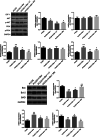Protective effects of berberine in a rat model of polycystic ovary syndrome mediated via the PI3K/AKT pathway
- PMID: 33709493
- PMCID: PMC8252786
- DOI: 10.1111/jog.14730
Protective effects of berberine in a rat model of polycystic ovary syndrome mediated via the PI3K/AKT pathway
Abstract
Background: Ber, a Chinese herbal monomer has been reported to exhibit an array of pharmacological activities related to the lowering of blood glucose and the treatment of polycystic ovarian syndrome (PCOS). In the present study, we aimed to elucidate the effect of berberine (Ber) on a rat model of PCOS mediated via the PI3K/AKT signaling pathway.
Methods: A PCOS animal model was induced with the administration of letrozole, and animals were then randomized into untreated or Ber and metformin hydrochloride treated groups. After administration, fasting blood glucose, HOMA-IR, fasting insulin (FINS) values, and the serum hormone levels were measured in PCOS rats. The ovarian tissues were stained with hematoxylin and eosin and terminal deoxynucleotidyl transferase-mediated dUTP-biotin nick end labeling (TUNEL) for pathological and apoptosis examination. Moreover, the effect of Ber on the proliferation and apoptosis of granulosa cells was detected by CCK-8 assays and flow cytometry. The influence of Ber on granulosa cells was confirmed by blockade of the PI3K/AKT pathway. In addition, the modulatory effect of the blockade of the PI3K/AKT pathway on the expression of related proteins was demonstrated via western blotting.
Results: We found that Ber was able to restore the serum hormone levels and improve IR in a PCOS rat model. The morphological lesions and apoptosis of the ovary were also restored by the Ber treatment. Blockade of the PI3K/AKT pathway attenuated the influences of Ber on the proliferation and apoptosis of granulosa cells.
Conclusion: The beneficial effects of Ber on PCOS included alterations of the serum hormone levels, recovery of morphological lesions in the ovary, improvement of insulin resistance, and cell viability and inhibition of apoptosis, which were all mediated through the PI3K/AKT pathway.
Keywords: PI3K/AKT pathway; berberine; insulin resistance; polycystic ovarian syndrome.
© 2021 The Authors. Journal of Obstetrics and Gynaecology Research published by John Wiley & Sons Australia, Ltd on behalf of Japan Society of Obstetrics and Gynecology.
Conflict of interest statement
The authors declare that they have no conflict of interest.
Figures









Similar articles
-
Guizhi Fuling Wan reduces autophagy of granulosa cell in rats with polycystic ovary syndrome via restoring the PI3K/AKT/mTOR signaling pathway.J Ethnopharmacol. 2021 Apr 24;270:113821. doi: 10.1016/j.jep.2021.113821. Epub 2021 Jan 16. J Ethnopharmacol. 2021. PMID: 33460753
-
Berberine decreases insulin resistance in a PCOS rats by improving GLUT4: Dual regulation of the PI3K/AKT and MAPK pathways.Regul Toxicol Pharmacol. 2020 Feb;110:104544. doi: 10.1016/j.yrtph.2019.104544. Epub 2019 Nov 26. Regul Toxicol Pharmacol. 2020. PMID: 31778716
-
Beneficial effects of Heqi san on rat model of polycystic ovary syndrome through the PI3K/AKT pathway.Daru. 2017 Oct 11;25(1):21. doi: 10.1186/s40199-017-0188-7. Daru. 2017. PMID: 29020999 Free PMC article.
-
Insulin resistance, autophagy and apoptosis in patients with polycystic ovary syndrome: Association with PI3K signaling pathway.Front Endocrinol (Lausanne). 2022 Dec 16;13:1091147. doi: 10.3389/fendo.2022.1091147. eCollection 2022. Front Endocrinol (Lausanne). 2022. PMID: 36589825 Free PMC article. Review.
-
Polycystic ovary syndrome management: a review of the possible amazing role of berberine.Arch Gynecol Obstet. 2020 Jan;301(1):53-60. doi: 10.1007/s00404-020-05450-4. Epub 2020 Feb 14. Arch Gynecol Obstet. 2020. PMID: 32060683 Free PMC article. Review.
Cited by
-
Regulation of Insulin Resistance, Lipid Profile and Glucose Metabolism Associated with Polycystic Ovary Syndrome by Tinospora cordifolia.Nutrients. 2023 May 9;15(10):2238. doi: 10.3390/nu15102238. Nutrients. 2023. PMID: 37242122 Free PMC article.
-
Natural compounds in the management of polycystic ovary syndrome: a comprehensive review of hormonal regulation and therapeutic potential.Front Nutr. 2025 Feb 11;12:1520695. doi: 10.3389/fnut.2025.1520695. eCollection 2025. Front Nutr. 2025. PMID: 40008316 Free PMC article. Review.
-
Therapeutic potential of Achillea millefolium L. extract on 7,12-dimethylbenz(a)anthracene (DMBA) -induced ovary cancer in Wistar rats: a biochemical, molecular and histopathological approach.Toxicol Res (Camb). 2025 Jan 8;14(1):tfae235. doi: 10.1093/toxres/tfae235. eCollection 2025 Jan. Toxicol Res (Camb). 2025. PMID: 39790360
-
Advancements in lead therapeutic phytochemicals polycystic ovary syndrome: A review.Front Pharmacol. 2023 Jan 9;13:1065243. doi: 10.3389/fphar.2022.1065243. eCollection 2022. Front Pharmacol. 2023. PMID: 36699064 Free PMC article. Review.
-
Fisetin mitigates letrozole-induced polycystic ovarian syndrome in rats: crosstalk of AMPK/PI3K/AKT-mediated-Nrf2 antioxidant defense mechanism and the inflammasome NLRP3/NF-κB P65/IL-1β signaling pathways.Naunyn Schmiedebergs Arch Pharmacol. 2024 Oct;397(10):8077-8088. doi: 10.1007/s00210-024-03124-5. Epub 2024 May 24. Naunyn Schmiedebergs Arch Pharmacol. 2024. PMID: 38789632
References
-
- Curi DD, Fonseca AM, Marcondes JA, et al. Metformin versus lifestyle changes in treating women with polycystic ovary syndrome. Gynecol Endocrinol. 2012;28:182–5. - PubMed
-
- Busiah K, Colmenares A, Bidet M, Tubiana‐Rufi N, Levy‐Marchal C, Delcroix C, et al. High prevalence of polycystic ovary syndrome in type 1 diabetes mellitus adolescents: is there a difference depending on the NIH and Rotterdam criteria? Hormone Res Paediatr. 2017;87:333–41. - PubMed
MeSH terms
Substances
Grants and funding
LinkOut - more resources
Full Text Sources
Other Literature Sources
Medical

